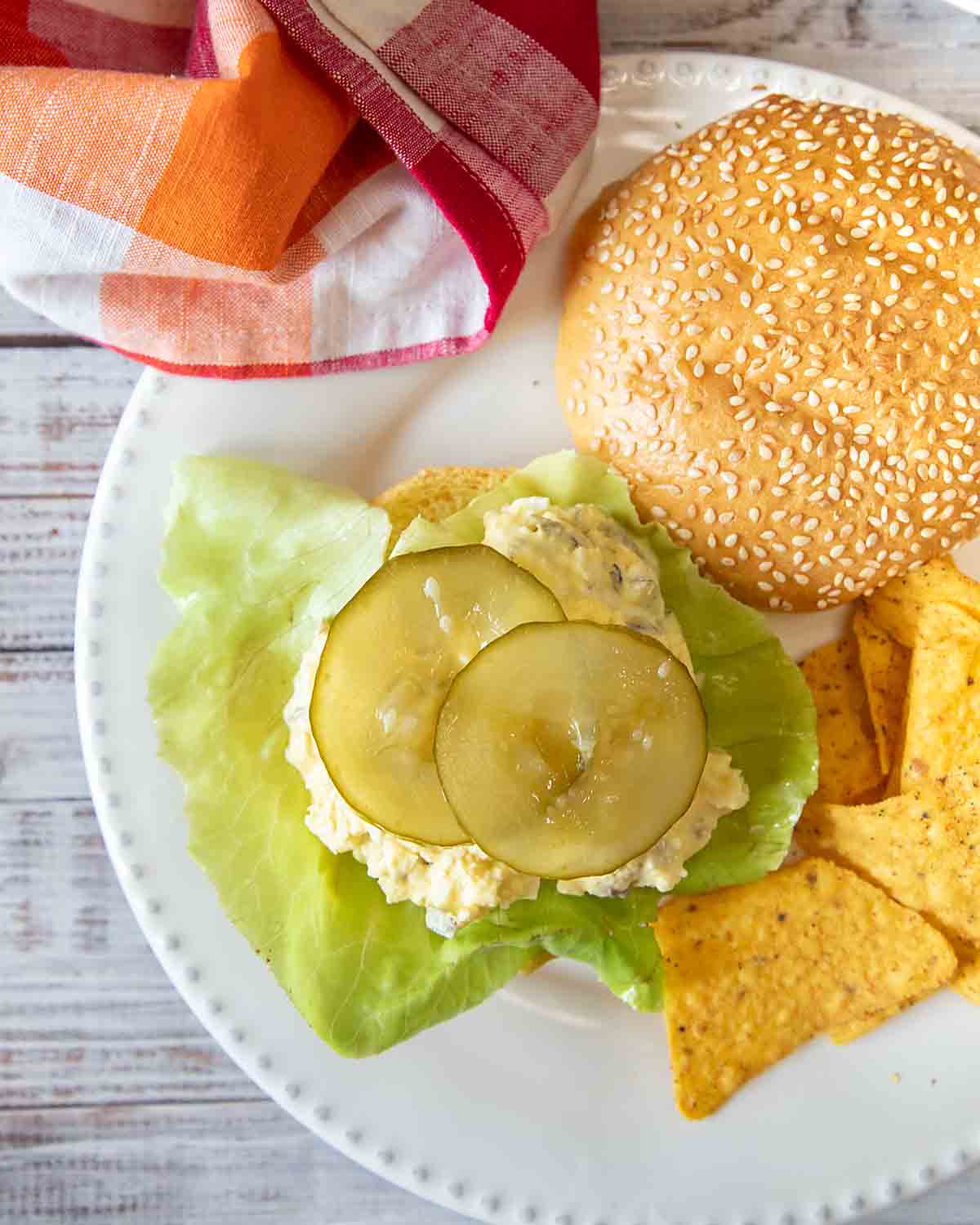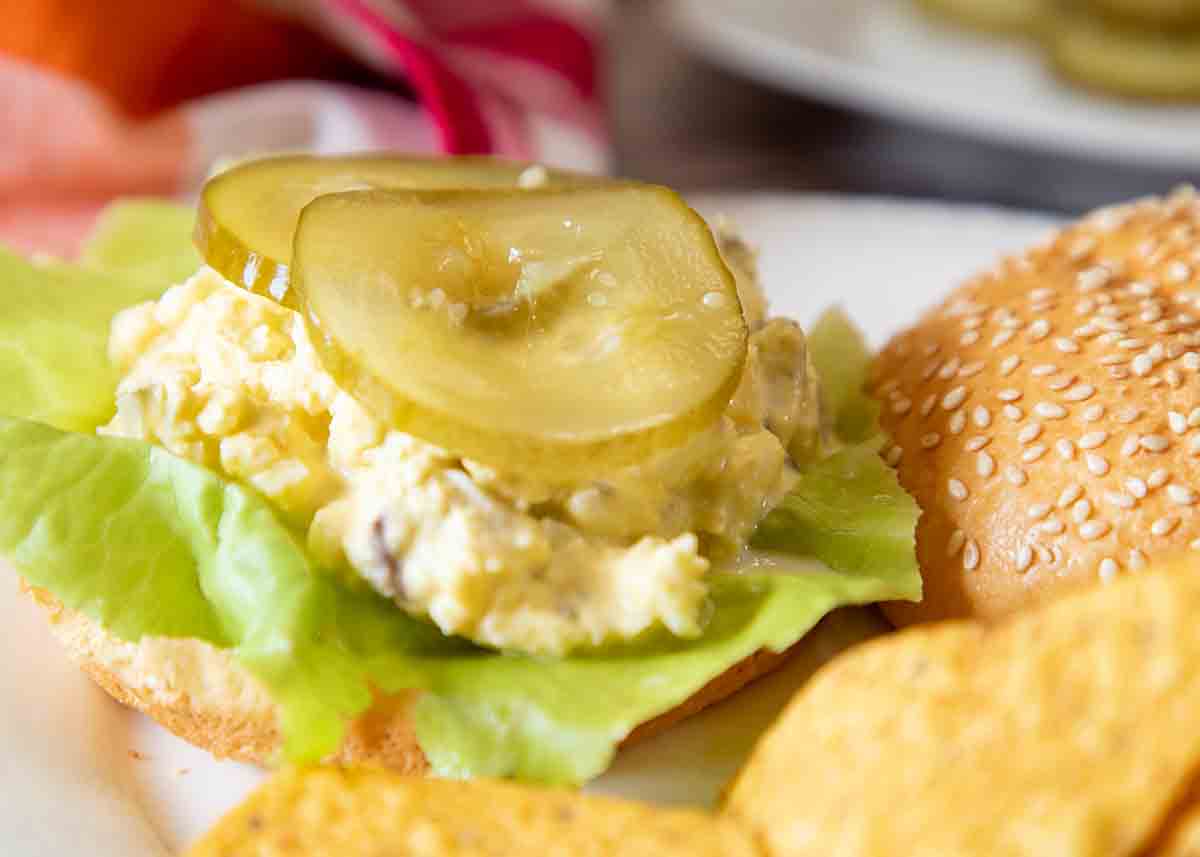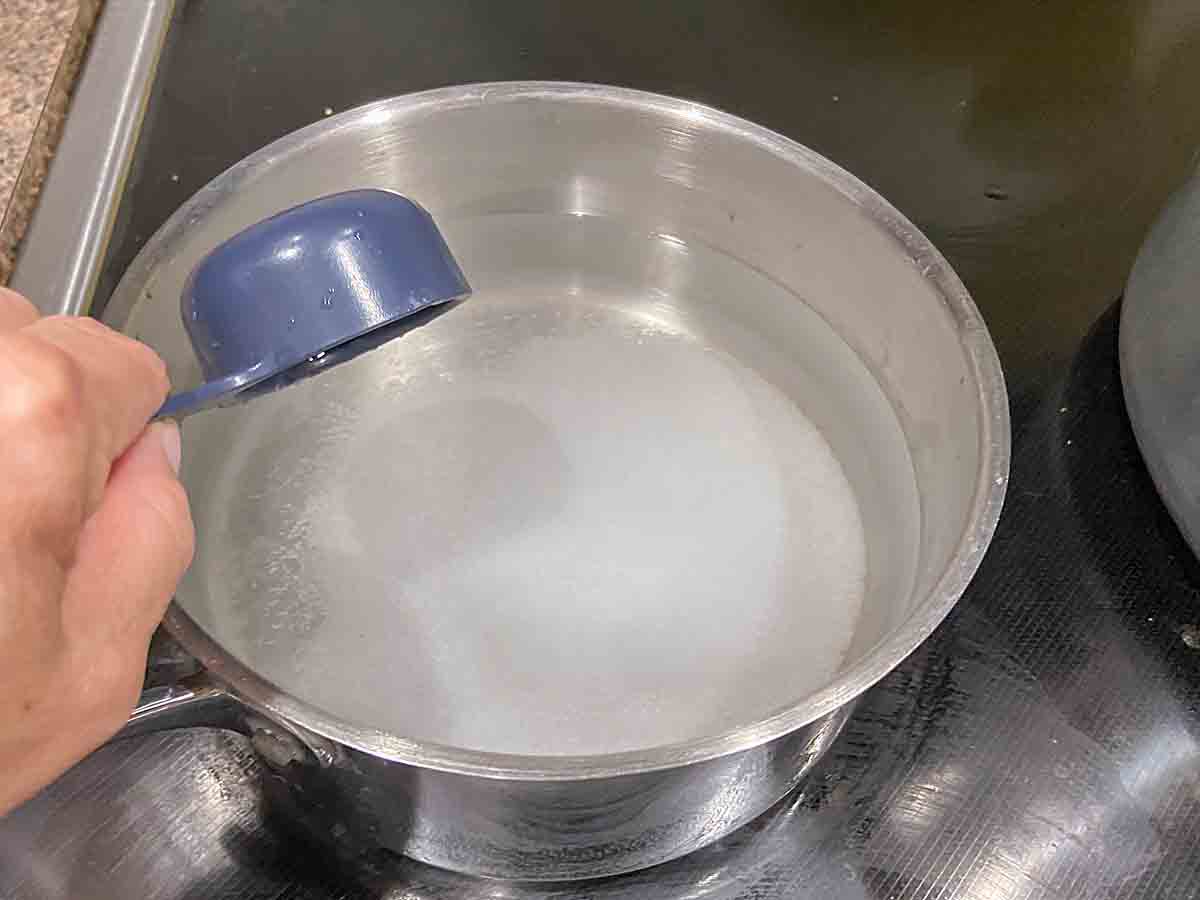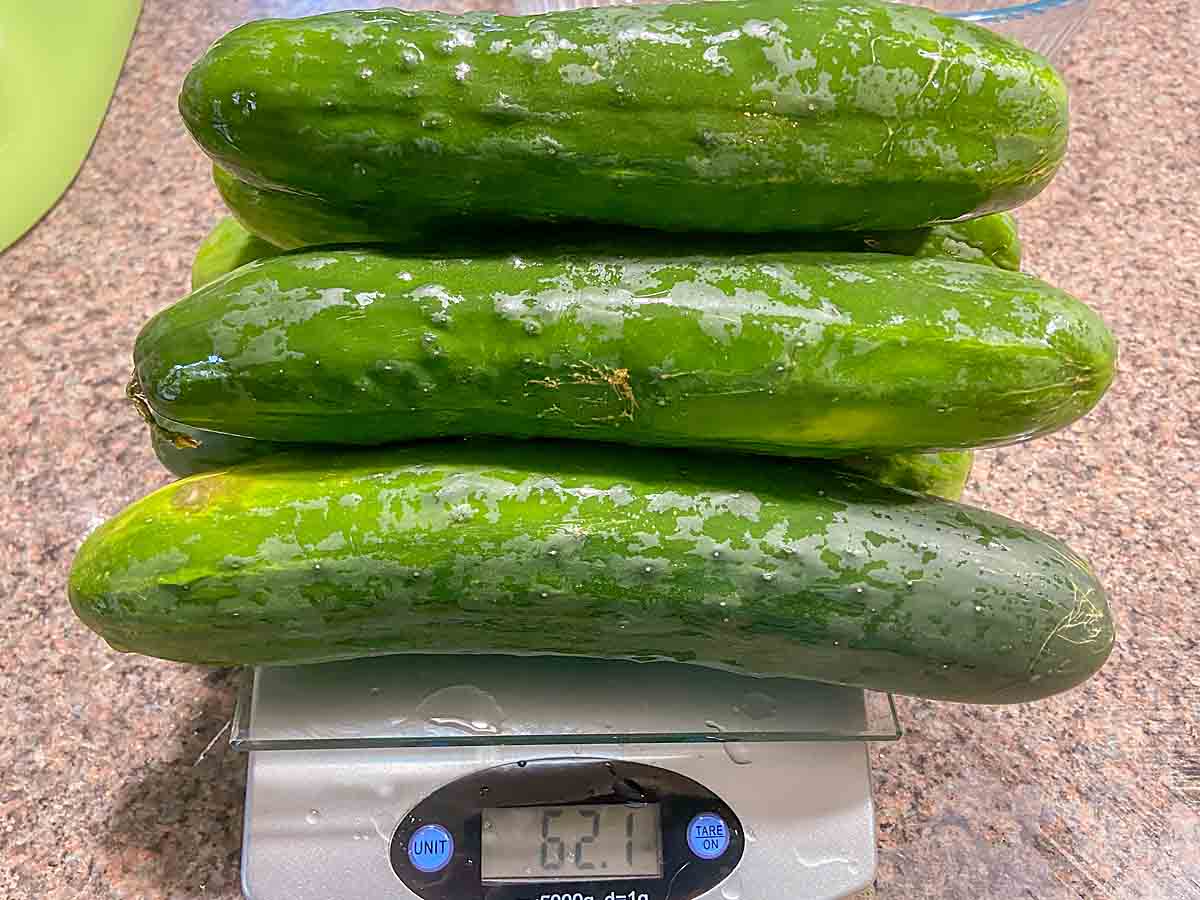Dill Pickle Slices
Tart, briny and flavorful, home-canned dill pickle slices will enhance your sandwiches, burgers and more all year. A perfect option for using up larger cucumbers. 
This page may contain Amazon or other affiliate links, which can earn me a small commission, please see my policy page for details.
When people think of homemade pickles, they often think whole pickles—or sometimes spears. But my favorite variety to can is Dill Pickle Slices (aka Dill Pickle Chips or Hamburger Pickles).
While whole pickles are fun and tasty, pickle chips are the real workhorse of the pickle world. Adding a big flavor boost, they shine topping sandwiches or burgers. And don’t forget that they’re a key ingredient in dishes like egg salad and tartar sauce.
Yes, pickles are a staple!
Every year, I make two or three multi-jar batches of Dill Pickle Slices. As an added benefit, this uses up my CSA cucumbers (which are never sized for canning whole). And it keeps my husband’s pickle addiction satisfied all winter!
What is the origin of this recipe?
When it comes to canning, you want to make sure your recipe is safe! Improperly home canned foods result in a few deaths every year. To deal with this you should go to trusted sources like university sites or the Ball canning site. They make a big investment in recipe testing and are more likely to be safe than your Grandma’s recipe or a 1960 canning book.
Because of this I hesitate to post canning recipes, but I got so tired of looking the base recipe up and cutting it in half that I decided to post it anyway! I took a recipe for standard dills and simply cut them up. The original instructions from the University of Wisconsin are located here (pg 21) .
Besides cutting the recipe in half and slicing my cukes, I did make a couple of other changes. First, I increased the vinegar slightly which is one of the few “safe changes” that are permissible in canning. I did this because a 1:1 ratio is starting to become the de facto standard—and frankly it’s just easier to work with.
Then, I left out the sugar, which I don’t like, and is there for flavor rather than food safety, per the University of California. And finally I omitted the the brine’s pickle spice because I don’t keep it on hand. These are plenty flavorful anyway!
Why You’ll Love This!
Tasty. Pickles are loaded with flavor and can put a sandwich or salad over the top!
Local, Seasonal Win. Pickles are an easy way to take the seasonal local harvest (your own, your CSA or farmer’s market) and extend it through the winter.
Versatile. I love knowing that I have pickles around all the time. Whether for a spontaneous Bloody Mary or extra flavor on a sandwich!
What You’ll Need
Ingredient Notes
- Cucumbers. These become the pickle slices.
- Vinegar. This gives the sour taste and preserves the pickles safely. Your vinegar needs to be a 5% concentration, so check the label.
- Pickling Salt. This adds flavor and contributes to safety. Pickling salt is best since it doesn’t have things like anti-caking additives. Kosher salt may be substituted.
- Water. This keeps your pickles from being too sour.
- Dill. This provides the classic dill flavor. You can use dill seed if fresh dill is unavailable.
- Garlic, Mustard Seed, Black Peppercorns. These add flavor to the pickles.
Special Tools
- Canning supplies including canner, grabber, rack, etc.
- Canning jars and lids. I recommend purchasing these locally, at places like home improvement stores, since shipping is high.
Step by Step Overview
If you haven’t canned before, you should familiarize yourself with the process first. Sources like the National Center for Home Food Preservation are excellent resources. These instructions assume that you know how to can and omit basic canning details.
Wash cucumbers. Trim and discard both ends of the cucumbers, then slice into ¼ inch thick slices by hand or using a mandoline.
Prepare brine by dissolving salt in water. Pour over cucumbers, cover and let stand about 8 hours. Drain.
Prepare pickling solution. Heat vinegar, salt and water to boiling in a large saucepan. Keep hot while you fill jars.
Place herbs and cucumber slices in hot jars. Cover with hot pickling solution, leaving proper headspace and remove bubbles. Wipe jar rims with a clean, damp cloth.
Cap jars with clean lids and rings. Adjust lids to finger tight. Process in a boiling water canner 10 minutes for pints, 15 minutes for quarts at 0-1000 ft altitude. Adjust for higher altitudes (e.g. add 5 minutes for 1000-6000 ft.). Finish and test lids per standard water bath canning practices.
How to Serve
My very favorite way to use dill pickle slices is atop sandwiches or burgers. In fact, we always called them Hamburger Dill Pickles! The combo of salty and sour, with a juicy crunch makes any sandwich better!
Besides sandwiches and burgers, these are useful in so many recipes. I use them in Tuna or Salmon melts, tartar sauce and egg salad, to name a few.
You can even use the pickle juice in Bloody Marys! 
Leftovers
A canned, unopened jar of pickles can be stored at room temperature, ideally in a cool, dark cupboard. Quality is generally best within a year or so. Ball and Kerr lids now say that the seal on their lids should last for 18 months–though in practice many people keep foods longer.
Old or new, always check that your seal is intact before opening a home canned food. A seal will sometimes spontaneously fail just sitting in the cupboard. Discard anything that isn’t sealed or appears “off” in any way.
The USDA says that once opened, pickles will last 1-3 months in your refrigerator. Pretty sure I’ve kept mine at least 3 months.
Variations
Sweet pickle slices are another popular sandwich pickles, but are not something I’ve ever warmed up to. They are similar but with a generous amount of sugar in the brine, giving them a sweeter, more relish-y, flavor.
You can also make pickle relish, which is something I enjoy having around. When I’m really lazy, I don’t even need to chop pickles to have them in a recipe! I use this recipe from the National Center for Food Preservation.
Tips & FAQs
I make my cucumber slices about ¼ inch thick. My mandoline has a setting for this. When I cut them, they always look a little too thick and I used to try to go slightly thinner. I eventually changed my mind about that since after the slices go through the canning process, the thinner slices tended to be a little fragile and would sometimes tear.
Don’t overfill your jars if you are canning these. That is the quickest way to seal failure!
If you are new to canning, or a wannabe, in addition the aforementioned site, consider checking out the Food in Jars blog which will have some more unique recipes that follow safe practices. And you can also join Facebook canning groups like the Food in Jars Community.
Can I skip the canning and just refrigerate these? Yes, you can. I’d recommend cutting the recipe in half then, because, as open jars, they should be used up within 3 months or so. (Note that some refrigerator pickles recipes that are not designed for canning may have less vinegar therefore spoil faster in the refrigerator). 
I love making my own vinegar, but I never use this for canning because the acidity levels haven’t been tested. For safe canning you need a 5% vinegar solution which is the standard in most (but not all) commercial vinegar. Check your label to be sure.
I label my jars with the month and year right on the lid with a sharpie (since you can’t reuse lids). If I do multiple batches in a month, I indicate them as batch 1, 2 etc.

Dill Pickle Slices
Ingredients
- 4 pounds cucumbers
Brine:
- 1 gallon water
- 6 Tablespoons canning and pickling salt
Pickling solution:
- 1 quart vinegar 5% acetic acid
- 1/4 cup canning and pickling salt
- 1 quart water
For the jars:
- 2 Tablespoons whole mustard seed (1 teaspoon per pint jar)
- 5-10 fresh dill heads (1-2 heads per pint jar, may substitute 1 teaspoon dried dill seed per pint jar)
- 4-6 garlic cloves (peeled, 1 per pint jar)
- 1 Tablespoon black peppercorns (1/2 teaspoon per pint jar)
Instructions
- Wash cucumbers. Trim and discard both ends of the cucumbers, then slice into ¼ inch thick slices by hand or using a mandoline.
- Prepare brine by dissolving salt in water. Pour over cucumbers, cover and let stand 8 hours. Drain.
- Prepare pickling solution. Heat vinegar, salt and water to boiling in a large saucepan. Keep hot while you fill jars.
- Into each hot jar, place 1 teaspoon mustard seed, 1-2 dill heads, 1 peeled garlic clove and ½ teaspoon black peppercorns. Top with sliced cucumbers, leaving ½ inch headspace. Cover cucumbers with hot pickling solution, leaving ½ inch headspace. Remove bubbles with a rubber spatula, wooden spoon handle or other non-metal utensil. Wipe jar rims with a clean, damp cloth.
- Cap jars with clean lids and rings. Adjust lids to finger tight. Process in a boiling water canner 10 minutes for pints, 15 minutes for quarts at 0-1000 altitude. Adjust for higher altitudes (e.g. add 5 minutes for 1000-6000 ft.). Finish and test lids per standard water bath canning practices.
Notes
Originally posted Jul 20, 2011











Should the water in the canner BE boiling when adding the filled jars, OR do the filled jars go into water bath, then heat to boiling to process?
The water should be boiling when you insert the jars. The time starts when the water comes to a boil again. As the post states, the recipe assumes you understand basic canning practices already and there are more things you’ll want to know. So please check out https://foodinjars.com/blog/new-to-canning-start-here-boiling-water-bath-canning/ to learn about this. It isn’t hard, but it’s important for canning safely.
Like this easy no-sugar lower salt canning brine sliced pickle recipe. I like to waffle slice the cucumbers when I can slicers. I also added a 1/4 tsp of ground coriander to each pint to add an additional flavor. Water brined overnight. Made 6 pints and they look awesome. The suggestions and responses after the recipe where real helpful. Thanks for sharing and posting this sliced pickle canning recipe.
So glad you enjoyed Steve–the coriander sounds good, in fact I just bought whole coriander seed so quite a coincidence. Did a big batch of pickles last week but have a few more cukes left–hmmm. Thanks for commenting!
I’m making this today. Thank you for a terrific small-batch recipe to use up those cukes that are too big to pickle whole.
One minor suggestion: the Ingredients list specifies:
“1 Tablespoon black pepper (1/2 teaspoon per pint jar)”
Suggest spelling it out as “black peppercorns” or even “whole black peppercorns” (peppercorns was mentioned in the Instructions section, but it’s easy to miss). People new to canning might assume they can use ground black pepper instead of whole peppercorns.
That’s a great idea on spelling out peppercorns Karen and I’ve updated the recipe. Thanks and hope you enjoy the pickles!
Can they stay in the brine longer than 8 hours?
Yes, they can brine a little bit more–or a little less (I rarely do exactly 8 hours). If you’re going much more than 8 hours, I’d suggest moving them to the refrigerator.
My pickles turned out soggy, no crisp. Any ideas
Thin pickle slices like this aren’t generally as crisp as whole pickles or spears. And we have never felt the need for them to be crisp for topping burgers, getting chopped into tarter sauce, etc. If you want crisper slices, you might try searching for a recipe for crisp pickles and then cutting the slices thicker, but they’ll probably still be less crisp.
How long should you let them sit before eating
Since these are sliced thin (versus whole small cucumbers) and heated in the canning process, they will absorb a lot of flavor right away. Of course I’m usually still finishing up last years pickles when the cucumbers come in and I start canning! But I know I sometimes get a jar that doesn’t seal so those go right in the refrigerator and are used as soon as we need them. They may possibly develop a little more flavor over the next few days, but should be good once they cool down.
Hope you enjoy Donnie!
Thanks for recipe and thorough pre-recipe narrative. I have not tried my processed pickles yet but all else has gone well. One note: check your recipe directions. I believe you have omitted writing “vinegar” from step 3. Your narrative includes this info but for processing safety you might want to edit: “3. Preparing pickling solution. Heat salt, water, and VINEGAR to boiling…”
Thanks again for this recipe.
Thanks so much for letting me know Jan. I have corrected this. Hope you enjoy!
I have not tried this recipe yet but I do have a question. Do you need to add a grape leaf to maintain crispness?
No, that’s really more of an issue with whole pickles than slices. And even then removing the blossom end is supposed to accomplish the same thing. as a grape leaf.
Do you refrigerate for those 8 hrs of marinating?
No I don’t. I suppose I might if it were 110 here and we didn’t have AC 🙂
I just made three runs of these pickles and I think the turned out amazing. My only question is I accidently added 1/2 cup of salt in the last batch. I didn’t realize this until after I canned them and was cleaning up and saw the 1/2 cup measuring spoon. Will this effect the ph of the solution? I’ve looked it up and am finding various differing things.
So you doubled the salt in the last batch? That shouldn’t be a problem.
Per Healthy Home Canning ( https://www.healthycanning.com/the-role-of-salt-in-home-canning/), “The USDA Complete Guide (2015) says salt is not required for fresh-pack (vinegar) pickle recipes, but that it absolutely is required for safety with fermented pickles.” If you’re not familiar, fermented is the type processed like sauerkraut rather than canned in vinegar.
So they may taste slightly saltier, but it’s not a safety issue. I like my pickles salty anyway! I’m happy to hear you are enjoying these!
Thank you so much for the quick response. I had doubled the previous run and forgot to scale the salt back down for just 5 jars instead of 10. So glad I don’t have to throw them out!
Me too!
I know this is an old post, but hoping to get an answer still. (Please!)
After draining the brine, should the cucumbers be rinsed before proceeding?
No, they don’t need to be rinsed. Good question.
I bet they’ll be great! Your definition at the top of the post made me laugh. 🙂
Pingback: Fresh Cucumber » From Cucumber to Hamburger Dill « Art of Natural Living
Thanks for sharing your process! These look great!
THanks. Looking forward to breaking open the first jar in a week or so!